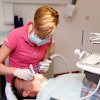
The California Dental Hygienists' Association (CDHA) claims it has increased membership since ending its 90-year affiliation with the American Dental Hygienists' Association (ADHA) in 2016.
The CDHA has also offered new benefits to its members, as well as worked to clear up any confusion about the future of the organization since the June 2016 decision to separate from the ADHA.
 Lory Laughter, RDH, is the president of the CDHA.
Lory Laughter, RDH, is the president of the CDHA."Membership is increasing weekly and has taken a jump since the introduction of new member benefits," stated CDHA President Lory Laughter, RDH, in an email interview with DrBicuspid.com. "Continued growth is a focus of the organization and is being realized."
However, Laughter declined to provide specific membership numbers.
ADHA, for its part, has been disappointed in the turn of events.
"It was challenging to lose a key constituent, but we remain hopeful that one day CDHA will join again with ADHA," stated ADHA President Tammy Filipiak, RDH, in an email interview with DrBicuspid.com. "We still believe we are stronger when we work together. In the meantime, we have been working to apply lessons learned from this experience and become a better organization as a result."
Since you been gone
Shortly after going solo, CDHA reduced its annual dues to $210 from the previous $350, of which 54% or $190 went to ADHA. In 2017, CDHA added group coverage for short- and long-term disability insurance, supplemental life, and accidental death and dismemberment insurance. Other member benefits include auto and home insurance and also financial and retirement planning, with more coming, according to Laughter.
“Membership is increasing weekly and has taken a jump since the introduction of new member benefits.”
Out-of-state membership, sometimes chosen by those who move after retirement, has been increasing, in addition to in-state membership, she noted.
"I can't put a limit on how much growth CDHA will see in the coming year, but the trend is encouraging," Laughter wrote.
Other changes include collaborations with associations and groups with goals similar to CDHA, which enable the organization to offer a growing number of continuing education opportunities and support for various oral health causes, Laughter added. These partnerships include working the Western Society of Periodontology and the California Society of Periodontists, the latter which teamed with the CDHA in 2016 to successfully introduce a bill recognizing March as Gum Disease Awareness Month in the state.
"CDHA has always been an active voice in the California Legislature and will continue that very important work," Laughter wrote.
The organization will keep working on issues important to its dental hygienist members, including labor laws and the issue of registered dental hygienists in alternative practice (RDHAP), she noted.
"The role of the RDHAP continues to be a focus for CDHA," she stated.
These hygienists provide essential oral care for many California residents unable to obtain care through the traditional private dental practice model, she explained.
"Recent changes and cuts in funding for services vital to oral and overall health threaten the ability of the RDHAP to provide care to the most vulnerable members of our population," Laughter wrote. "Up to 50% of Californians lack adequate access to oral healthcare. Hygienists realize prevention is key in improving public health, and the RDHAP is in the position to provide those key services."
The association is looking to expand the settings where a hygienist can provide care and also the scope of their allowable duties and functions. Overall, Laughter emphasized the importance of membership in CDHA and that laws and regulations affecting registered dental hygienists are made on the state level.
"We are seeing a shift in the model of dental care delivery from the one-owner practice to corporate chains," she stated. "How will the individual hygienists have an impact on ensuring there is a role for dental hygienists in future models of healthcare delivery? Membership magnifies your voice."
Changes
Continuing to be affiliated with ADHA would have required accepting a new charter agreement with the national organization that 50 constituents (representing the other 49 states and Washington, DC) ended up signing. The new charter agreement also would have required the California organization to turn over all of its assets to the national group if ADHA terminated the affiliation. Another concern for CDHA was a noncompete clause that would have forbid CDHA from forming its own organization for two years.
Since then, ADHA has made some changes.
"We have invested in new resources to support state leaders and have adjusted some of our expectations based upon feedback from our constituents," ADHA President Filipiak wrote. The organization also remains open to communication with CDHA leadership, she added.
"We feel we have addressed CDHA's concerns as part of a yearlong effort with our states to clarify and improve the charter agreement that we have with each constituent," she stated.
Has CDHA's detaching from ADHA had an impact on the national organization's membership?
"It's difficult to say how or if CDHA had a direct impact on membership levels," Filipiak wrote. "Like a lot of associations today, ADHA has seen a gradual decline over the last 10 years. That said, we exceeded our goal for new members this past summer cycle and are excited to build on this energy moving forward."
ADHA currently has 30,000 members, of whom 1,400 are in California, the state with the largest membership.
"ADHA is working hard to provide new and important resources to dental hygienists," Filipiak noted. "We have a number of ways we will continue to support our members in California and around the country by providing access to timely education, grants and scholarships, emerging technologies, breaking research, and career support."
Many of the priorities of ADHA and CDHA are similar, including labor laws.
"Our goal remains to ensure access to quality oral healthcare, promote and support dental hygienists in the many roles they serve, and continue to be aware of the many things that impact dental hygienists at the local, state, and national levels," Filipiak wrote.
Other programs offered by ADHA include publications, continuing education courses, scholarships, webinars, career development resources, and the organization's annual conference, she noted.
Rumor has it
The most difficult thing for CDHA over the past year has been dispelling rumors, according to Laughter.
"The most common reaction I witnessed surrounding the split was confusion," she wrote. "CDHA members and nonmembers alike wanted to know what the split meant for them personally."
Aside from that, Laughter has received largely positive reactions. She looks forward to working with ADHA on issues of mutual interest, although there are currently no joint endeavors between them.
"I know both organizations are focused on labor law for registered dental hygienists, and I can see an opportunity for collaboration on those issues," Laughter stated.


















